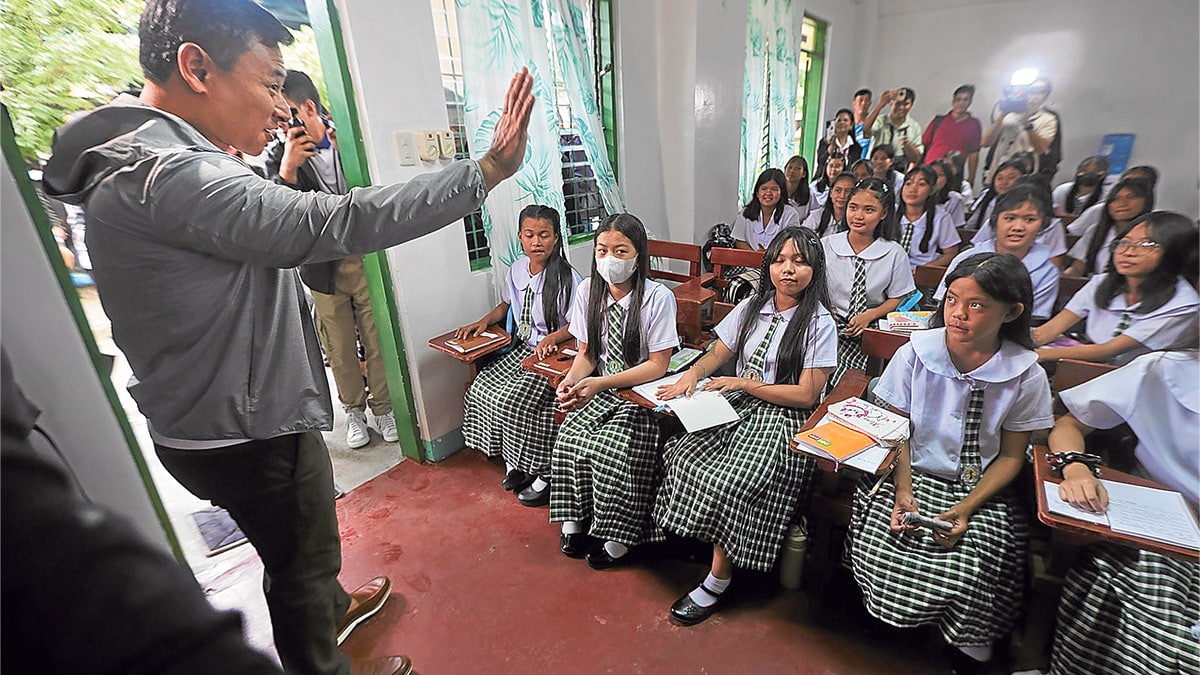PH schools open amid familiar woes

SECRETARY ON-SITE Education Secretary Juan Edgardo Angara greets a class in Carmona, Cavite, as he visits several schools in Calabarzon region to observe the opening of classes on Monday. —Grig C. Montegrande
MANILA, Philippines — The new school year started as scheduled on Monday in areas spared by Supertyphoon Carina (international name: Gaemi) around the country but teachers and students had to face the usual problems ranging from simple section transfers to the yet-to-be-solved classroom shortage on the first day of classes.
Education Secretary Juan Edgardo Angara visited schools in Calabarzon (Cavite, Laguna, Batangas, Rizal, Quezon) region and Muntinlupa City in Metro Manila on Monday as he wanted to see the situation on the ground and check if there were problems that teachers and parents would raise.
Data from the Department of Education (DepEd) showed a total of 17,979,764 students enrolled for School Year 2024-2025 in the country’s public elementary and high schools, while another 2,366,925 students in private schools. Alternative Learning System schools posted an enrollment of 222,067, DepEd said.
READ: 832 public schools delay opening due to Carina
Most enrollees were in public schools in Calabarzon, with 2,589,902 students, followed by Central Luzon with 1,917,619 and Metro Manila with 1,820,055. These regions suffered the brunt of Carina and most schools here had delayed the opening of classes amid cleanup activities and while many classrooms were being used as evacuation centers.
Article continues after this advertisementDepEd said 842 schools did not hold classes on Monday, affecting 803,824 students in typhoon-hit areas in Metro Manila and the Ilocos, Central Luzon, Calabarzon and Soccsksargen (South Cotabato, Cotabato, Sultan Kudarat, Sarangani, General Santos) regions.
Article continues after this advertisementIn a television interview, Angara said “98 percent” of schools in the country proceeded with the school opening.
Education officials were expecting that enrollment would still increase in the following days or weeks as schools were accommodating late enrollees.
Shared rooms
The problem of a classroom shortage was felt in Lagro High School, one of the biggest schools in Quezon City, as two sections shared a single classroom on Monday.
A head teacher from the school, who asked not to be named in this report, told the Inquirer that the shortage had been a concern since the previous school year, forcing teachers to split a classroom to accommodate more students.
In one of the classrooms that the Inquirer saw inside the school, two Grade 8 classes were sharing a room and the only thing that kept them apart was a plywood partition.
Overall, 22 sections share 11 classrooms at Lagro High School, a major concern that teachers admitted was “hard to resolve immediately.”
Some classes had to be held online so different sets of students could use the classrooms.
“We know that it’s not ideal and it’s very painful to see, but we have no other choice,” the teacher said in Filipino. “After all, education is for everyone and we are duty-bound to accept all students who want to study here.”
According to the teacher, they are hoping the classroom shortage will be solved once the construction of another building, which will house laboratories for science classes, is finished.
Asked when the building would be available, the teachers said the Department of Public Works and Highways did not give them a timeline.
Situation in the regions
In Baguio City, all 67 public elementary and high schools opened on Monday for the first day of a new school year, despite gloomy skies and brief rains, according to city schools division chief Soraya Faculo.
Enrollment reached 55,674, she said, observing that more children also turned up with their parents to enroll at the last minute for the school year on Monday.
At the rate of ongoing enrollment in Baguio, “we are expecting 64,000 pupils for this school year,” Faculo said.
On its social media page, DepEd said only two schools in the region would not hold in-person classes on Monday and would adopt alternative learning methodologies instead. These were Irisan Elementary School in Baguio, which is under construction, and Abucot Integrated School in Kabayan, Benguet, because of a landslide near the area.
In southern Luzon, more schools in different parts of Calabarzon suspended classes in public and private schools on Monday due to bad weather and continuous clearing operations by authorities in typhoon-hit areas.
On Sunday night, the DepEd in Calabarzon reported that at least 66 schools in different parts of the region suspended the opening of classes after the onslaught of Carina. They will start the school year on Aug. 5.
In Central Luzon, the police deployed about 1,000 personnel in the region “to provide public safety and police visibility in schools, colleges, universities, and nearby areas” on the first day of classes.
Brig. Gen. Jose Hidalgo Jr., regional police director, said police assistance desks had been set up in schools. —with reports from Vincent Cabreza, Delfin T. Mallari Jr. and Jun A. Malig